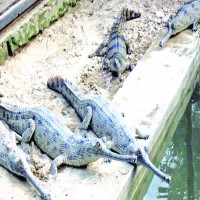No Growth of Gharial in Natural Habitat

By Shanta Adhikari, Chitwan, Feb. 27: The protection of the Gharial (Giavalis gagenticus) crocodile, the main species of the wetland ecosystem, is proving to be an increasing challenge lately.
Though the Gharial Breeding center that is located near Kasara headquarters of the Chitwan National Park (CNP) has seen its major success, still could not remain untouched from the challenges in term of fulfilling the purpose for which the center was set up for.
Annath Baral, Chief Conservation Officer of the CNP said that despite being successful on achieving unexpected returns, the center has still a long way to go to increase the projected number of Gharial crocodiles.
"The center was established in 1978 and after 10 years of its establishment, the center has been continuously releasing the crocodiles of Gharial species in natural habitat but to no avail as the rise in the number of Gharial species still remains a far cry," said Chief Conservation Officer, Baral.
The baby Gharial that is born, bred, and reared has been released on different rivers and lakes, but the growth in the number of Gharial crocodiles has not been as expected.
So far, more than 1,600 crocodiles have been released to different rivers by the center. However, as many as 200 crocodiles only can be seen on the natural inhabitant.
The center has been established to ease the breeding and releasing process of the Gharial crocodiles with an aim to increase the number of crocodiles in the natural habitat. Here, the center breeds the baby crocodiles after collecting eggs of the Gharial crocodiles and then release them on the natural habitat as soon as they become able to find their own feed.
Although the Conservation Center, a genetic bank for crocodiles, has succeeded in producing crocodiles, it has not been able to increase the number of crocodiles in its natural habitat.
The conservationists lend a reason for the increasing water pollution, deficiency of the fishes that are the main feed of crocodiles, trapping of crocodiles in fish traps, and surging plastic materials in main sources of water for blocking the rise in the Gharial crocodile species.
Other than that, the human encroachment and haphazard eating of the laid eggs of crocodiles has proved to be the major obstruction to protect crocodiles in their natural habitat.
Likewise, many crocodiles that sail as far as India mist the flooding doesn’t return, so this also hinders on the rise in the number of the Gharial crocodiles in natural habitat.
The center was established from the joint effort of the Nepal government as well as the Frankfort Geological Society of Germany. The center has been receiving many foreign donations for the operation.
The Gharial species which lives only in clean water and eats fish as feed is a mammal of the wetland ecosystem.
It is believed that the disappearance of this species is a serious cry for attention as the situation clearly indicates the further consequence and effects on other species as well.
Recent News

Do not make expressions casting dout on election: EC
14 Apr, 2022
CM Bhatta says may New Year 2079 BS inspire positive thinking
14 Apr, 2022
Three new cases, 44 recoveries in 24 hours
14 Apr, 2022
689 climbers of 84 teams so far acquire permits for climbing various peaks this spring season
14 Apr, 2022
How the rising cost of living crisis is impacting Nepal
14 Apr, 2022
US military confirms an interstellar meteor collided with Earth
14 Apr, 2022
Valneva Covid vaccine approved for use in UK
14 Apr, 2022
Chair Prachanda highlights need of unity among Maoist, Communist forces
14 Apr, 2022
Ranbir Kapoor and Alia Bhatt: Bollywood toasts star couple on wedding
14 Apr, 2022
President Bhandari confers decorations (Photo Feature)
14 Apr, 2022











